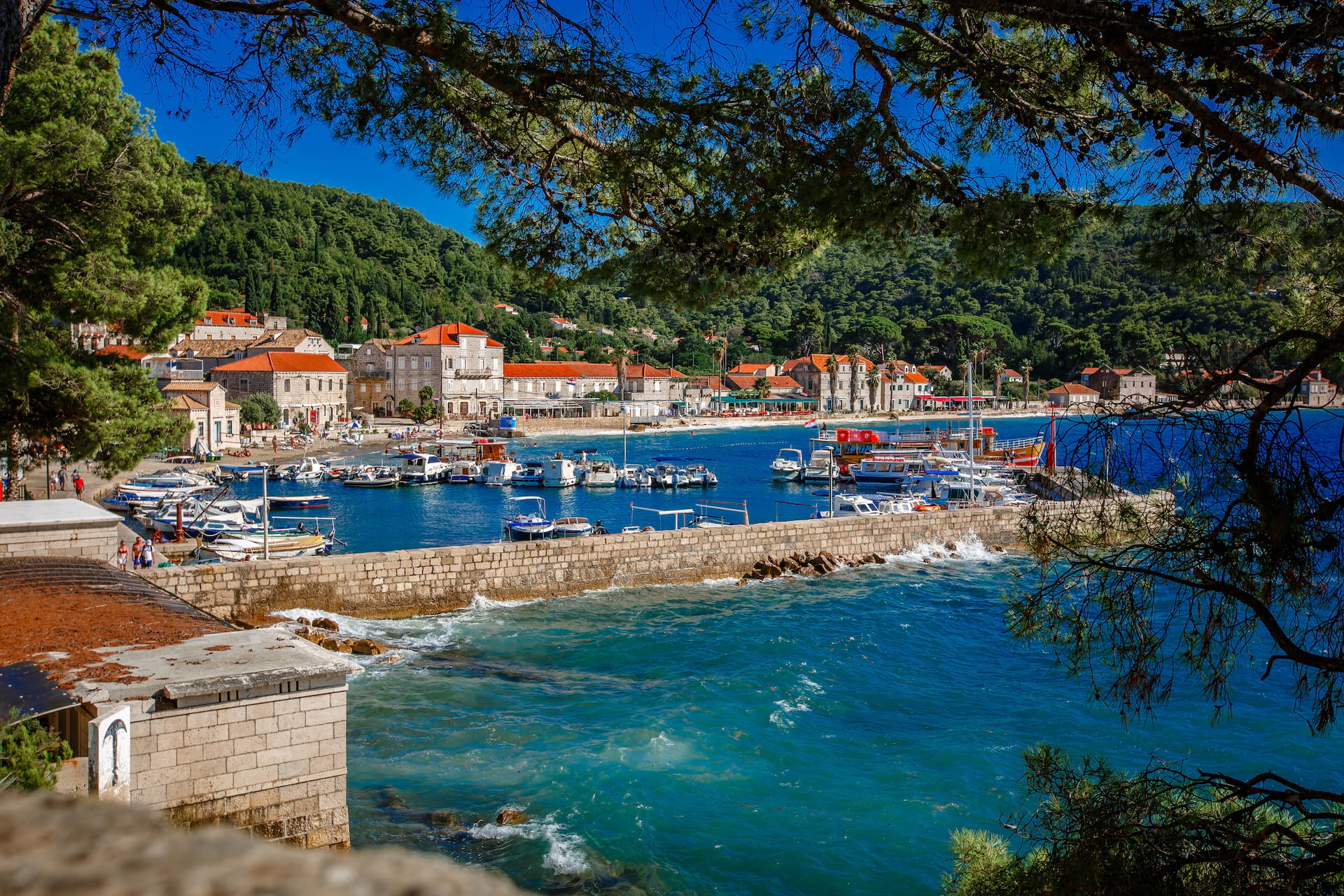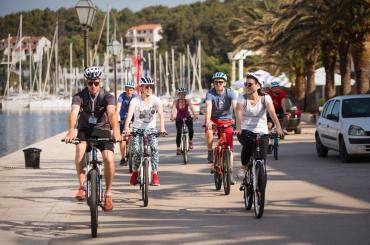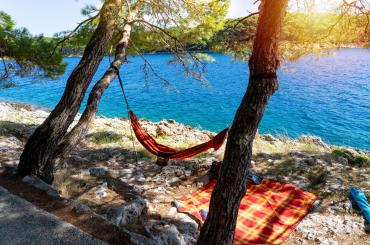The Elaphites have a total land area of around 30 square kilometres and a population of 850 on just three permanently inhabited islands. These islands sit off the coast of Dubrovnik, making it an easy day trip, perfect if you need a refreshing break from the Old Town tourist crowds.
The islands are mostly covered in sub-tropical flora and are on top of the dolomitic limestone surface, mainly jagged rocks shaped through the power of the sea over time. Therefore, they provide unique cliff diving, snorkelling or scuba diving opportunities.
Only three of them, Koločep (locally known as Kalamota), Lopud and Šipan, are inhabited and have tourism amenities.
Places to visit: beaches, caves, churches...
Known as Elafiti locally, the islands have a long history of human settlements and activity. Roman author Pliny the Elder was the first to mention the Elaphiti Islands in the 1st century AD. The name comes from "elaphos", the Ancient Greek word for deer. There is no evidence of deer inhabiting the archipelago, and the name might have been a metaphor.
 Photo: Nad Tochiy
Photo: Nad TochiyKoločep is the southernmost inhabited island in Croatia, with a the population of 163
Whichever Island of the Elaphiti archipelago you choose as your base, it will reward you with some spectacular swimming spots. The coastline is predominantly rocky, which might put some people off, but there are also plenty of pebbly and sandy beaches.
A must-visit point on Koločep is a Blue Cave on the southwestern part of the Island (not to be confused with the Blue Cave of Biševo), only accessible by boat. Its name comes from the blue shade of the waters inside. It is wide enough to enter without difficulty, but its opening is barely visible from the outside.
Whether kayaking or chartering a yacht, ask your trip designer about some of the hidden beaches and tiny bays
There are quite a few famous beaches in the Dubrovnik area. Some are popular with locals, some with tourists, but none is universally as loved as Sunj Beach, located at the south-eastern end of Lopud Island, facing Dubrovnik. It is Elaphiti's most popular port of call for private and chartered boats.
You can get to it on foot from Lopud village by following one of the marked footpaths through the woods. Sunj Beach has amenities like a bar, restaurant and lounge chairs.
Šipan, with its two picturesque large villages of Suđurađ and Šipanska Luka, offers plenty of options for leisure and fun beach activities. However, experienced Šipan lovers know the Island is home to many hidden beaches and tiny bays best accessed by boat. Whether kayaking or chartering a yacht, ask your trip designer about some of them, or better yet, surprise yourselves by discovering them yourself.
Taking a hike is a must
Hiking on Koločep is a must. Island's western side is covered in the pine forest, going straight to the edge of tall cliffs hiding small bays below. Hiking and walking around this area are perfect for recharging your batteries. There are no dangerous animals or venomous snakes on the Island, so the only real danger one might face is taking on a bit more hiking than planned.
Following the hiking path through the woods, you eventually end up at the Koločep lighthouse standing on a small cliff with a great view of Dubrovnik and the Island of Daksa.
 Photo: WitR
Photo: WitRHiking across Šipan means walking through olive orchards and shrubs of Mediterranean aromatic herbs
Below the lighthouse is a natural pool carved in the rocks, and obviously, it is a perfect swimming spot.
Šipan Island is also a great walking, hiking or trekking destination. The Island houses 39 old churches and 42 medieval residences. Hiking across Šipan means walking through olive orchards and shrubs of Mediterranean aromatic herbs.
The bay of Lopud is also home to a few beautiful former homes and summer residences of the local aristocracy
Lopud Village on the Island, bearing the same name, is one of the most beautiful urban centres of the 15th and 16th century Dubrovnik area. Historical stone houses, charming streets and storefronts offer plenty to explore as you wander around.
The fortified complex of the Franciscan Monastery built in the late 15th and early 16th centuries dominates the entrance to the bay. The monastery features a 30m (98 feet) tall bell tower and a defensive fortress dating to 1592. The bay of Lopud is also home to a few beautiful former homes and summer residences of the local aristocracy. Several churches and chapels are waiting to be caught by your mobile phone's camera.
 Photo: RnDms
Photo: RnDmsThe Lopud Franciscan Monastery was founded in 1483 on the east side of the island overlooking Lopud bay
Behind the village is a hiking path that will take you to the top of St. Simeon Hill overlooking the Island. The most spectacular view is from Sutvrac Fort, built in 1563. It is a must-see spot for all those fit enough to hike for an hour up a rocky, steep terrain of Lopud island.
Glorious naval history
The Elaphiti Islands were a part of the Dubrovnik Republic and contributed to its success. Known simply as "Isola di Mezzo" or "The Middle Island" for much of its history, Lopud was an important location in the 15th and 16th centuries. In 1457, Lopud boasted 4000 inhabitants, compared to around 150 year-round residents on record today. It was also the home port for approximately 80 merchant ships and was a considerable maritime power due to its skilful seafarers and captains.
 Photo: Jason Wells
Photo: Jason WellsThe dwellers of Koločep used to be the best-known coral divers in the Mediterranean
Koločep Island is known for Red Mediterranean coral, the only natural precious material in the Dubrovnik area. The Dubrovnik Republic, in its heyday, became known for high-quality jewellery produced by its skilled goldsmiths and silversmith. Islanders of Koločep quickly caught on and developed unique techniques for extracting coral from the Adriatic and even the Aegean Sea. They would sell the expensive material to Dubrovnik jewellery makers and became rich.
In the Mediterranean style, fresh fish is always the right choice, although locals also love their octopus, calamari or prawn dishes
Šipan Island is known for olive oil production, and the Guinness Book of Records recognised it as the place with more olive trees per capita than any other in the world. It shows how important these natural symbols of the Mediterranean climate are to the local population.
Olive oil, garlic and parsley
The Elaphiti Islands are located in the very south of Croatia, meaning they have a particular reputation to uphold when it comes to delicious local food, especially seafood. In the Mediterranean style, fresh fish is always the right choice, although locals also love their octopus, calamari or prawn dishes. Boiled leafy greens, like Swiss chard, cabbage or spinach, and potatoes, are the most popular sides for seafood dishes. Olive oil is always an essential addition, along with garlic and parsley. This trio is an absolute must when eating fish grilled over an open flame on what is locally known as "gradele".
You should try the local wine. Even if you have yet to plan on trying Croatian wine, there will rarely be anything else on restaurants' wine lists.
 Photo: OPIS Zagreb
Photo: OPIS ZagrebPanoramic wiew of the Elaphiti Islands with a nearby Korcula town in the front
Croatia is an Old World winemaking country with a vast diversity of wine varieties and styles.
The Elaphiti Islands were all known for grapes and wine throughout their history. Unfortunately, the times have changed in this respect. There is no more wine production on Koločep, but Lopud and Šipan are doing better in this respect.
Whether you choose Dubrovnik as your base or one of the Elaphiti islands, plan your time well to make the most of your stay.





